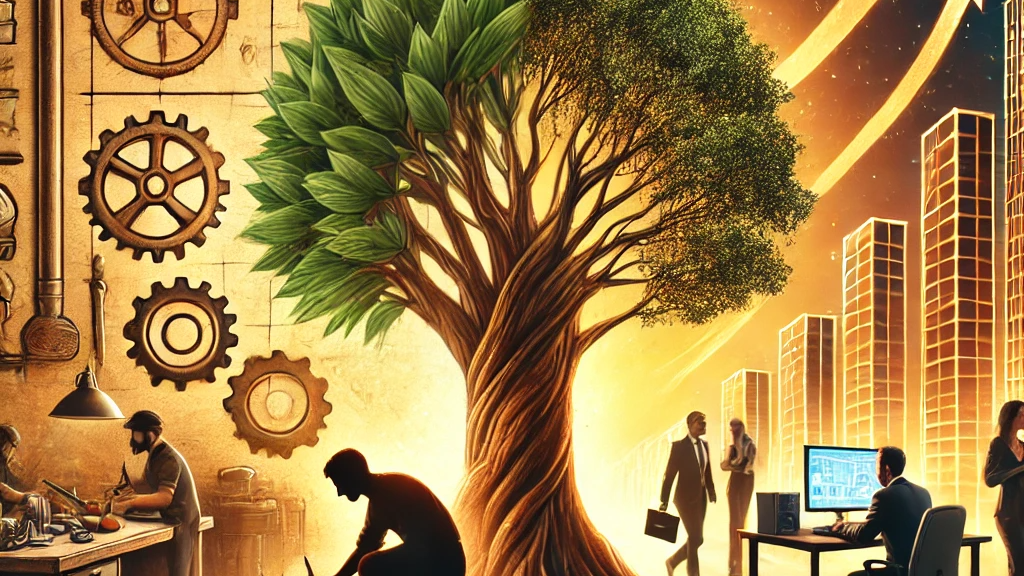
Beyond the Craft: The PrestaRock’s Adolescence Period
Everything I described in the last two posts can be compared to raising a child. I have often said and written that building a company felt like raising a child. Like any first-time parent, I had no idea how things would turn out—but they did. On one hand, things naturally fell into place, while on the other, I had to educate myself by reading books and seeking knowledge.
In my previous post, I mentioned a book with a simple title but profound content that completely changed my perspective on leadership. I realized that a leader’s role is not just about managing projects or writing specifications but about nurturing and building a team, being an integral part of it, leading by example, and developing essential soft skills.
Unveiling the essence of leadership pushed me to explore even further. I felt as if I had climbed a small hill only to discover towering mountains in the distance that I had yet to scale. This growth stage is best described as transitioning from helplessness—when everything seems to be going wrong, and self-doubt creeps in—to the realization that the answers exist. All that remained was to follow the right path, keep learning, and trust that things would eventually align.

Knowing that there are answers brings a sense of calm. This realization applies not only to leadership but also to training employees. A newly hired employee often feels like a cat thrown into water—wide-eyed, panicked, and searching for stability.
I constantly questioned why I struggled to get employees to adhere to basic work ethics and consistently show up on time. Do I need to teach each one how to issue invoices personally? Should I repeatedly explain how to use our project management system, ASANA, or how to communicate with clients? These thoughts kept running through my mind. How do employees in other companies show up and know what to do?
At first, I assumed they were like me—quick learners who adapted by observation. But when hiring junior specialists, I realized this wasn’t always the case. They needed structured guidance, clear explanations, and knowledge transfer. The challenge was that I had no idea how to do this. I couldn’t even visualize it. And as A. Einstein famously said, imagination is everything. If you can’t envision a solution, you can’t solve the problem.
This led to my next phase of growth, which focused on addressing structural challenges. As a technical person, I found these easier to grasp. The second pivotal book I read was From Craft to Business by Nerius Jasinavicius . Its title perfectly matched my company’s transformation.
For the first four years, we operated like a craft workshop. I was the shoemaker, repairing shoes while a few apprentices learned alongside me. And we lived pretty well. However, the book was challenging, mainly due to its heavy emphasis on workflow processes and complex formulas. The key takeaway was the fundamental difference between craft and business.
As my colleague Nerius puts it, business must generate revenue. As a skilled craftsman, I prioritized delivering high-quality service over maximizing profit. This mindset continues to shape my approach today. I believed that if you worked well, money would follow. While this was partially true, I learned that it didn’t mean undervaluing services or neglecting the financial aspect of business.
The second significant realization was understanding that a business is a system. I should not be involved in every task but rather focus on the most strategic work. Although business experts like Brian Tracy emphasize hiring people with lower hourly rates for routine tasks, this realization didn’t come instantly. I fell into the common leadership trap of believing that since I knew how to do something best, I should do it myself.
The third lesson was about constraints, decision-making, and systematization—essentially an introduction to the Theory of Constraints. The book didn’t provide a step-by-step guide on creating and documenting processes but served as a gateway to deeper learning. I strongly recommend similar training for any leader.
The fourth insight revolved around vision, mission, and values. I used to dismiss these as corporate slogans displayed on office walls and websites. Over time, I realized that company culture is authentic and is shaped by clearly defined goals and a well-articulated vision. It took nearly four years of running a business for me to understand this.
The fifth challenge was managing budgeting, cash flow, and workflow processes. At first, these concepts seemed abstract. Reading about them felt like reading about soft skills—you acknowledge their existence but don’t fully grasp their impact. Only later did I appreciate the significance of their role in business operations.
The sixth realization, which came later, was that leadership can be lonely. There is growing discussion about how business owners often feel isolated in their journey. I certainly felt that way. Despite setting an example—working long hours, following Brian Tracy’s principles, upholding core values—it seemed employees didn’t care. It felt like they weren’t invested in me, the company, or its success. I was alone.
This loneliness disappeared when I joined the annual From Craft to Business (AMVER) training program. It was designed for people like me who unintentionally found themselves running businesses. Through structured lessons, weekly discussions, and peer support, I gained knowledge and a sense of community.
I realized that I was not alone. Even leaders of companies with fewer than 100 employees faced similar struggles. I remember a story about the CEO of one of Lithuania’s largest chemical factories. He signed off on every toilet paper purchase, and without his approval, nothing happened. He had built an entire conglomerate by centralizing control.
I had to choose my path. Seeing how this company crumbled after the CEO’s passing, I knew that wasn’t the answer. I was also exhausted from doing everything myself. I no longer wanted to feel alone or work the hardest.
I set a new goal: to build a structured, scalable company. I sought inspiration from DevBridge, a company I admired for its blend of American efficiency and high-quality leadership. My vision was to lead an international company with ~200 employees, where I no longer needed to be involved in daily operations.
Brian Tracy taught: Find a role model and become them. I chose Viktoras Gurgždys whom I had the chance to meet during my university years. His leadership resonated with me, and I envisioned myself following a similar path.
And how did it all unfold? That’s a story for the next post.